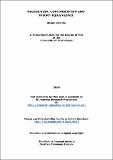Files in this item
Necessitism, contingentism and theory equivalence
Item metadata
| dc.contributor.advisor | Read, Stephen | |
| dc.contributor.advisor | Uzquiano, Gabriel | |
| dc.contributor.author | Jacinto, Bruno | |
| dc.coverage.spatial | xiv, 248 p. | en_US |
| dc.date.accessioned | 2016-05-17T11:46:02Z | |
| dc.date.available | 2016-05-17T11:46:02Z | |
| dc.date.issued | 2016-06-23 | |
| dc.identifier.uri | https://hdl.handle.net/10023/8814 | |
| dc.description.abstract | Two main questions are addressed in this dissertation, namely: 1. What is the correct higher-order modal theory; 2. What does it take for theories to be equivalent. The whole dissertation consists of an extended argument in defence of the joint truth of two higher-order modal theories, namely, Plantingan Moderate Contingentism, a higher-order necessitist theory advocated by Plantinga (1974) and committed to the contingent being of some individuals, and Williamsonian Thorough Necessitism, a higher-order necessitist theory advocated by Williamson (2013) and committed to the necessary being of every possible individual. The case for the truth of these two theories relies on defences of the following metaphysical theses: i) Thorough Serious Actualism, according to which no things could have been related and yet be nothing, ii) Higher-Order Necessitism, according to which necessarily, every higher-order entity is necessarily something. It is shown that Thorough Serious Actualism and Higher-Order Necessitism are both implicit commitments of very weak logical theories. Prima facie, Plantingan Moderate Contingentism and Williamsonian Thorough Necessitism are jointly inconsistent. The argument for their joint truth thus relies also on showing i) their equivalence, and ii) that the dispute between Plantingans and Williamsonians is merely verbal. The case for i) and ii) relies on the Synonymy Account, an account of theory equivalence developed and defended in the dissertation. According to the account, theories are equivalent just in case they have the same structure of entailments and commitments, and the occupiers of the places in that structure are the same propositions. An immediate consequence of the Synonymy Account is that proponents of synonymous theories are engaged in merely verbal disputes. The Synonymy Account is also applied to the debate between noneists and Quineans, revealing that what is in question in that debate is what are the expressive resources available to describe the world. | en_US |
| dc.language.iso | en | en_US |
| dc.publisher | University of St Andrews | |
| dc.rights | Attribution-NonCommercial-NoDerivatives 4.0 International | * |
| dc.rights.uri | http://creativecommons.org/licenses/by-nc-nd/4.0/ | * |
| dc.subject | Modal metaphysics | en_US |
| dc.subject | Theory equivalence | en_US |
| dc.subject | Truth in-truth at distinction | en_US |
| dc.subject | Higher-order modal logic | en_US |
| dc.subject | Verbal disputes in metaphysics | en_US |
| dc.subject | Necessitism-contingentism debate | en_US |
| dc.subject.lcc | BC199.M6J23 | |
| dc.subject.lcsh | Modality (Logic) | en_US |
| dc.subject.lcsh | Metaphysics | en_US |
| dc.title | Necessitism, contingentism and theory equivalence | en_US |
| dc.type | Thesis | en_US |
| dc.contributor.sponsor | Fundação para a Ciência e Tecnologia (Portugal) | en_US |
| dc.type.qualificationlevel | Doctoral | en_US |
| dc.type.qualificationname | PhD Doctor of Philosophy | en_US |
| dc.publisher.institution | The University of St Andrews | en_US |
The following licence files are associated with this item:
This item appears in the following Collection(s)
Except where otherwise noted within the work, this item's licence for re-use is described as Attribution-NonCommercial-NoDerivatives 4.0 International
Items in the St Andrews Research Repository are protected by copyright, with all rights reserved, unless otherwise indicated.


